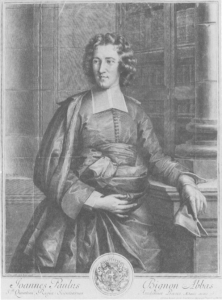Small Treasures in the Library: From Bibliothec Bignon
Posted in From the Library on July 5 2016, by Jane Lloyd
Jane Lloyd is a volunteer in the LuEsther T. Mertz Library of The New York Botanical Garden.

Old and rare books are most prized for their special characteristics of publication and form, less so for inscriptions and signatures put in them by their owners. However, these inscriptions and signatures, bookplates, and other marks of ownership often vividly illuminate the lives and times of their owners.
A copy of Quadripartitum botanicum de simplicium medicamentarium facultatibus… by Simon Paulli (1603–1680), published in 1708, in the Rare Book Collections of the Mertz Library reveals through its notable first owner European society being transformed by science and a new spirit of international cooperation at the beginning of the 18th century. This thick volume of materia medica written by a Danish scholar and court physician was regarded at the time as the standard work on medical pharmacology and an essential reference volume for contemporary physicians and scientists.
Stamped in gold on the front and back covers of the brown leather binding of the book is a coat of arms with the words “BIBLIOTHEC BIGNON.” The heraldic device and inscription indicate that the book comes from the personal library of Abbé Jean-Paul Bignon (1662–1743), President of the French Academy of Sciences and royal librarian to Louis XV of France, and teacher of Sir Hans Sloane (1660–1753), an important British physician and naturalist. Another pupil, botanist Joseph Pitton de Tournefort, named the genus Bignonia after him in 1694.
He built up a large personal library, making an effort to acquire as many French and foreign scientific publications as possible. As director of the book trade in France from 1699 to 1714, Bignon received a copy of each new book published in France. He also sought out and bought copies of foreign publications from publishers, booksellers, and scholars throughout Europe. One of Bignon’s most helpful foreign contacts was the British naturalist Sir Hans Sloane, a physician and collector whose collection became the foundation of the British Museum and whose house in Chelsea became the Chelsea Physic Garden. He sent Bignon many English scientific publications and news of new scientific discoveries made in England. Bignon opened his library to French and foreign scholars and members of the public for their use in order to advance scientific discovery and learning.
In 1718 the regent for Louis XV appointed Bignon Royal Librarian with instructions to reorganize and improve the Bibliothèque du Roy. He tackled his new responsibility with great enthusiasm, getting a new building for the library and creating a systematic program to purchase books. Just as he had done with his personal library, Bignon allowed scholars and members of the public access to the royal library. When he became Royal Librarian, Bignon sold his personal library to John Law (1671–1729), a Scottish economist and Controller General of Finances in France for Louis XV. Later that year Law’s financial speculations led to his downfall and bankruptcy, forcing him to flee France.
Bignon’s practice of opening his personal library and the royal library to the public, so that scholars like Voltaire (1674–1778) could use its books, and his penchant to acquire scientific publications and disseminate discoveries, especially in botany, foreshadow the founding of the LuEsther T. Mertz Library some two centuries later.
Image courtesy of Wikimedia Commons.


Jane, This was fascinating, thanks.Please write about more of our treasures!